De Novo Synthesis of Fatty Acids: Acetyl CoA is used in fatty acid synthesis after its carboxylation and conversion to malonyl CoA. In the cytosol, acetyl CoA is Carboxylated to malonyl CoA by a biotin-containing enzyme, referred to as acetyl CoA carboxylase. This coenzyme is covalently linked to the lysys residue of the enzyme, which requires ATP and CO2 (as HCO3-).
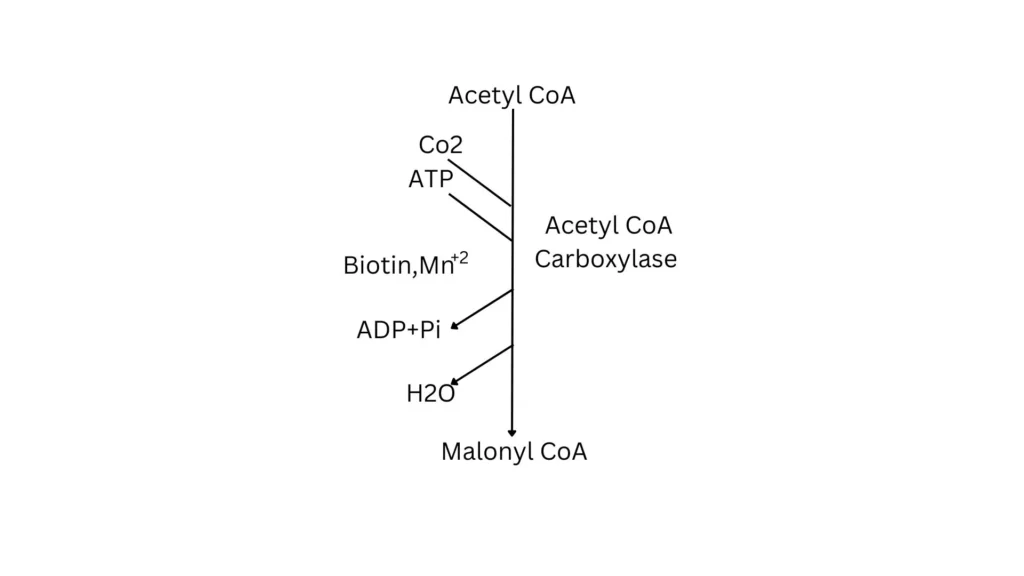
Prolonged consumption of high calorie diet increases synthesis of the enzyme Acetyl CoA carboxylase while fasting or low calorie diet decreases its synthesis.
De novo Synthesis of Fatty Acids : Palmitic Acid
An enzyme referred to as fatty acid synthase catalyzes the remaining reactions of fatty acid synthesis, in eukaryotes. It is a multifunctional, dimeric enzyme, composed of the two identical subunits. Its each monomer is a multicatalytic polypeptide with seven different enzyme activities plus a domain that covalently binds a molecule of 4′-phosphopantotheine. During fatty acid synthesis, 4-phosphopantotheine carries acetyl and acyl units on its terminal thiol (-SH) group.
In prokaryotes, fatty acid synthase is a multienzyme complex and the 4′-phosphopantotheine domain is present on a separate protein, referred to as acyl carrier protein (ACP).
Individually, different enzyme activities of the fatty acid synthase complex are designated as acetyl CoA-ACP acetyl transacylase, malonyl CoA-ACP transacylase, p-ketoacyl-ACP synthase (condensing enzyme), B-ketoacyl ACP reductase, ẞ-hydroxyacyl ACP dehydratase and enoyl-ACP reductase. These enzyme activities are separate catalytic domains that are present on each subunit of the multicatalytic fatty acid synthase complex.
Fatty acid synthase contains two-SH groups, called pantotheinyl-SH group, which is referred to as the ACP-SH, and the thiol-SH group that is designated as the CYS-SH.
- Fatty acid synthesis starts with the transfer of the molecule of acetate, from acetyl CoA to the ACP-SH This reaction is catalyzed by the acetyl CoA-ACP acetyl transacylase domain of the fatty acid synthase complex.
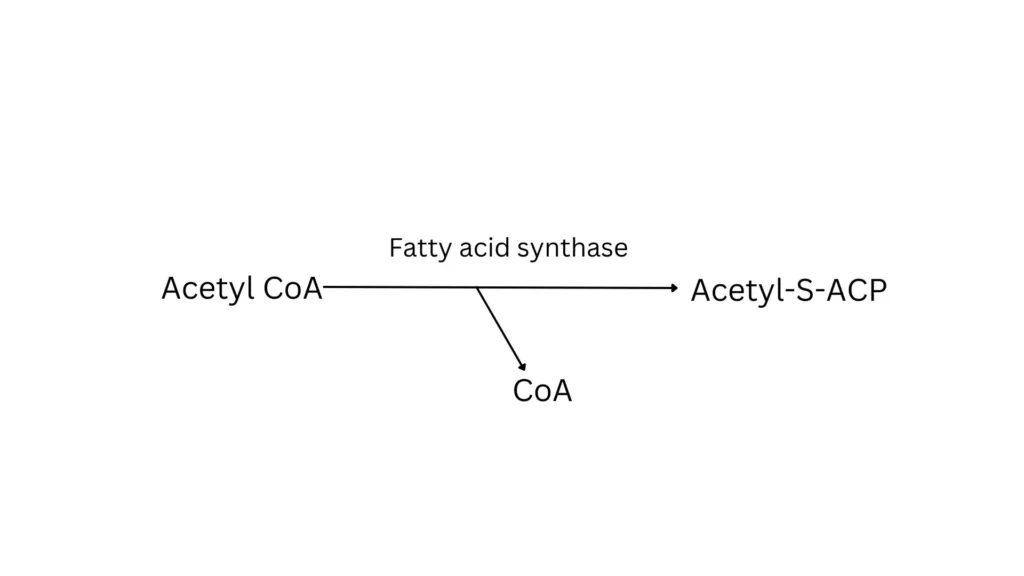
This two-carbon fragment is transferred to the CYS-SH, which is a temporary holding site.
- At the same time, malonyl CoA-ACP transacylase domain of the fatty acid synthase transfers three malonate unit from malonyl CoA to the vacant -sh group of ACP.
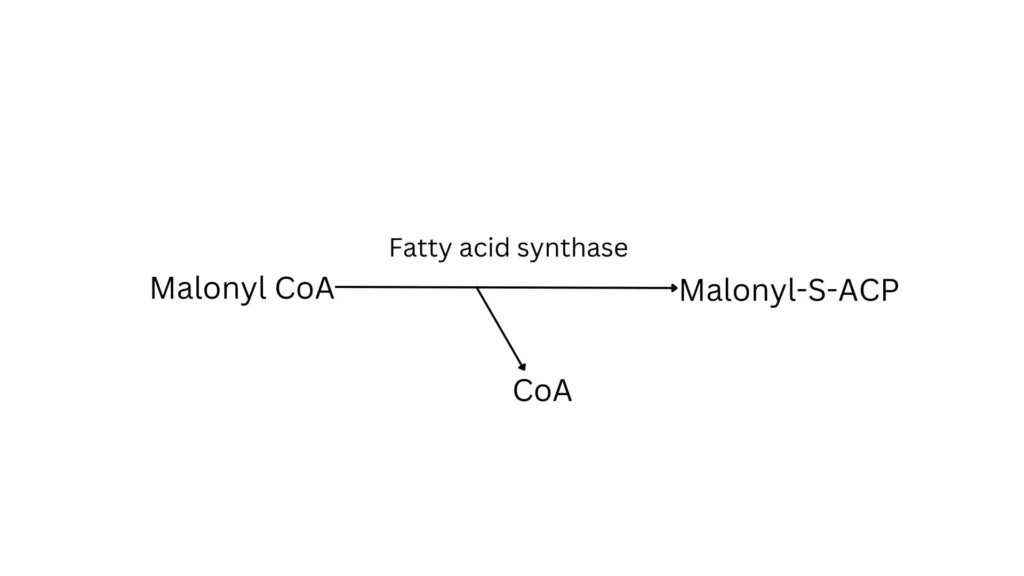
- In the next step, malonyl group loses CO2, and transfers the acetyl group, by β-ketoacyl ACP synthase domain of the fatty acid synthase, which in turn causes condensation of the two acetyl group on the CYS-SH and forms a four carbon acetoacetyl unit that is attached to the ACP domain.
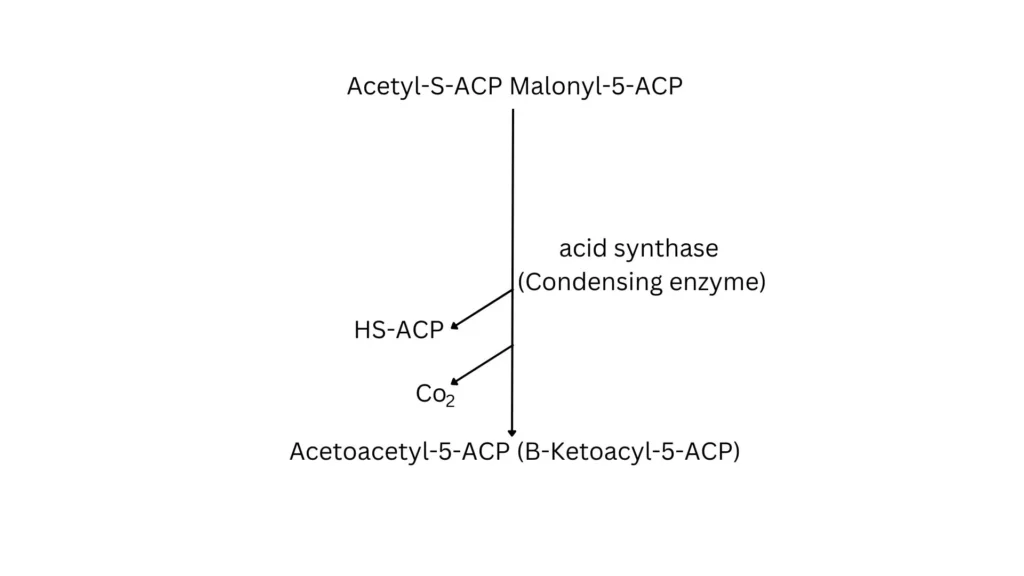
- β-Ketoacyl ACP reductase domain of the fatty acid synthase reduces keto group of the acetoacetyl-S-ACP to β-hydroxybutyryl-S-ACP (β-hydroxyacyl-S-ACP).
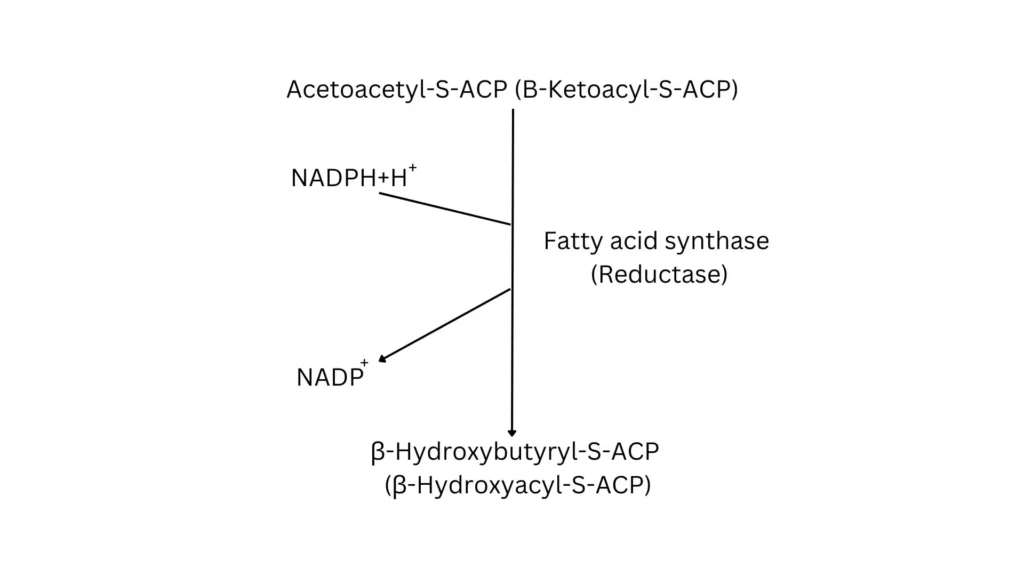
- β-Hydroxyacyl-ACP dehydratase domain of the fatty acid synthase removes a molecule of H2O from β-hydroxyacyl-S-ACP and introduces a double bond in it, to form crotonyl-S-ACP (α,β-unsaturated-acyl-S-ACP).
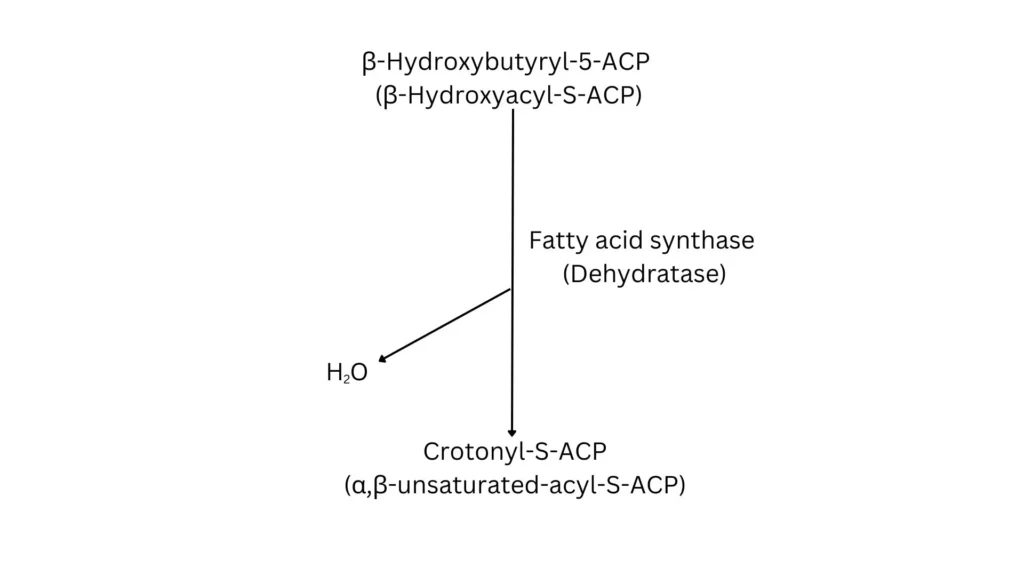
- Crotonyl S-ACP is reduced by the enoyl-ACP reductase domain of the fatty acid synthase and is converted to butyryl-S-ACP(acyl-S-ACP)
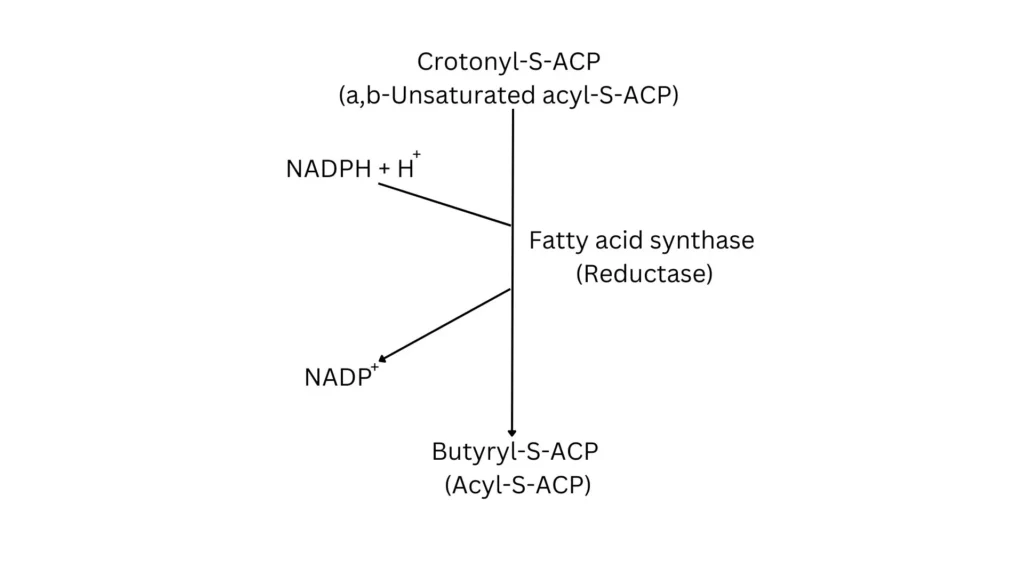
As a result of these reactions, a four-carbon compound is formed whose three terminal carbons are fully saturated and remain attached to ACP.
These steps are again repeated, beginning with the transfer of the butyryl chain to the CYS-SH. This cycle of the reactions is repeated five more times, each time incorporating two carbon units, that are derived from malonyl CoA and are attached to the growing fatty acid chain at the carboxyl end. When the chain length reaches 16 carbons, the process is terminated with the formation of palmitoyl-S-ACP. Thereafter, palmitoyl thioesterase cleaves the thioester bond with the release of palmitate.
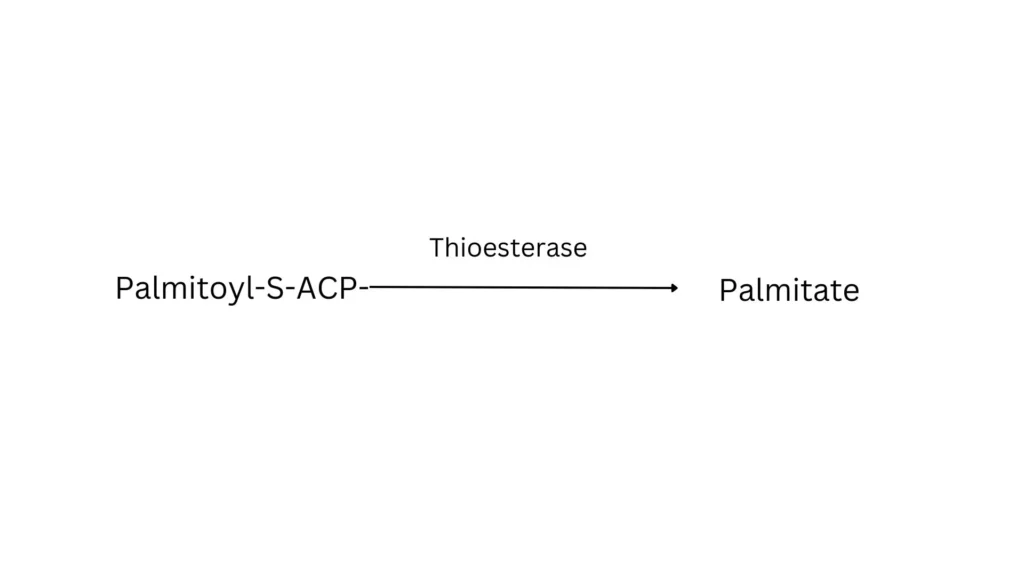
Reducing equivalents (NADPH+H+), which are used in the biosynthesis of fatty acids, are derived from the pentose phosphate pathway.
Read more : What is Glycolysis ? Definition, Equation, Pathway Explained step by step
De Novo Synthesis of Fatty Acids Diagram
The overall reaction of de novo synthesis of fatty acids (Palmitic acid) is given in the diagram below.
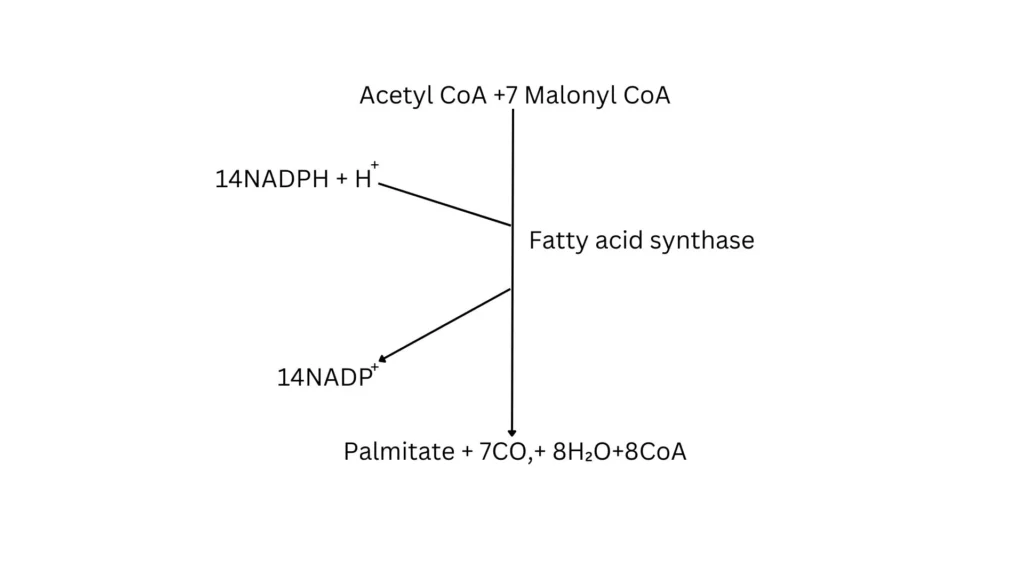
Read more : Entner Doudoroff Pathway (ED Pathway) : alternate Glycolysis Cycle
Regulation of Fatty Acid Synthesis
- The rate-limiting step in the synthesis of fatty acids is the conversion of acetyl CoA to malonyl CoA. This reaction is catalyzedby the enzyme acetyl CoA carboxylase which is stimulated by citrate.
- Citrate, allosterically, activates acetyl CoA carboxylase, while a long chain fatty acyl CoA acts as an allosteric inhibitor, Insulin also stimulates activity of this enzyme. A high carbohydrate diet increases production of acetyl CoA which in turn increases the citrate pool. Thus, a high carbohydrate diet leads to increased fatty acid synthesis. Insulin also reduces CAMP level, inhibits activation of the hormone sensitive lipase and favors lipogenesis.
- On the other hand, glucagon increases cAMP level, activates lipase activity and inhibits fatty acid synthesis. Glucagon thus promotes release of fatty acids from the adipose tissue (lipolysis) and opposes lipogenesis.
- Fatty acid synthase is the other key enzyme of the palmitate biosynthesis. A high carbohydrate diet or a fat free diet stimulates fatty acids synthase activity. On the other hand, a high fat diet, fasting and glucagon decrease enzyme synthesis.
- Phosphorylated sugars, eg:glucose-6-phosphate, also activate this enzyme.
